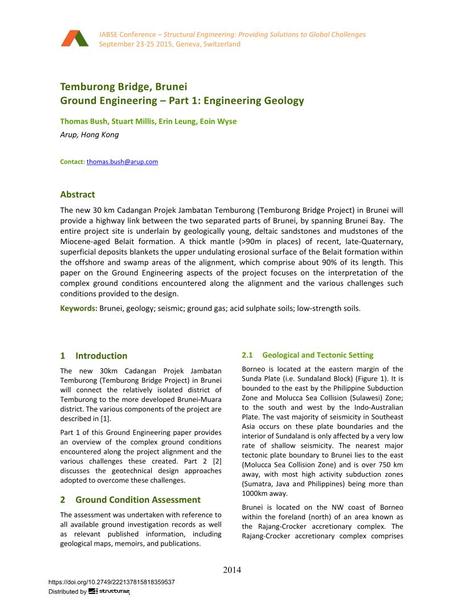Temburong Bridge, Brunei – Ground Engineering - Part 1: Engineering Geology

|
|
|||||||||||
Détails bibliographiques
| Auteur(s): |
Thomas Bush
(Arup, Hong Kong)
Stuart Millis (Arup, Hong Kong) Erin Leung (Arup, Hong Kong) Eoin Wyse (Arup, Hong Kong) |
||||
|---|---|---|---|---|---|
| Médium: | papier de conférence | ||||
| Langue(s): | anglais | ||||
| Conférence: | IABSE Conference: Structural Engineering: Providing Solutions to Global Challenges, Geneva, Switzerland, September 2015 | ||||
| Publié dans: | IABSE Conference Geneva 2015 | ||||
|
|||||
| Page(s): | 2014-2021 | ||||
| Nombre total de pages (du PDF): | 8 | ||||
| Année: | 2015 | ||||
| DOI: | 10.2749/222137815818359537 | ||||
| Abstrait: |
The new 30 km Cadangan Projek Jambatan Temburong (Temburong Bridge Project) in Brunei will provide a highway link between the two separated parts of Brunei, by spanning Brunei Bay. The entire project site is underlain by geologically young, deltaic sandstones and mudstones of the Miocene-aged Belait formation. A thick mantle (>90m in places) of recent, late-Quaternary, superficial deposits blankets the upper undulating erosional surface of the Belait formation within the offshore and swamp areas of the alignment, which comprise about 90% of its length. This paper on the Ground Engineering aspects of the project focuses on the interpretation of the complex ground conditions encountered along the alignment and the various challenges such conditions provided to the design. |
||||
| Mots-clé: |
sols sulfatés acides sols peu résistants
|
||||
